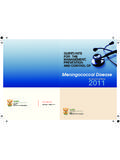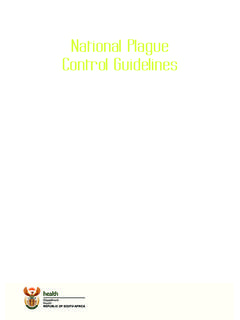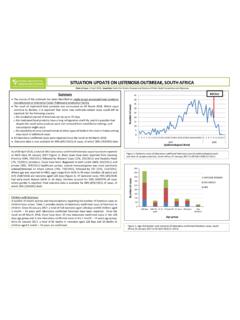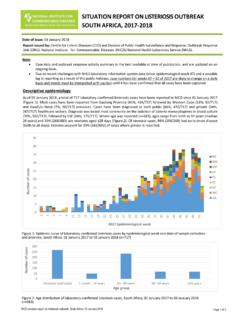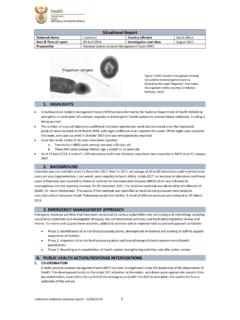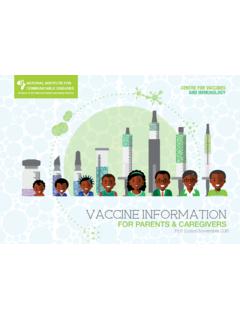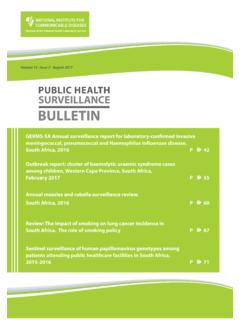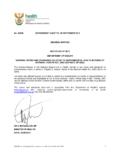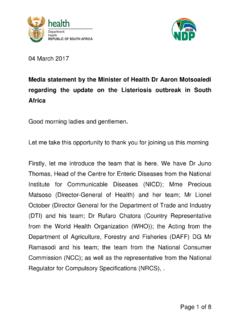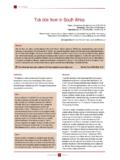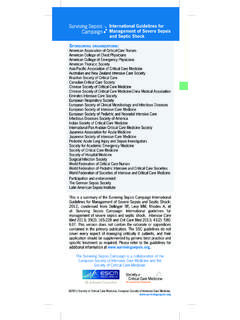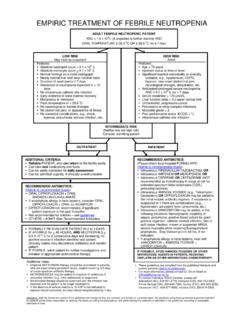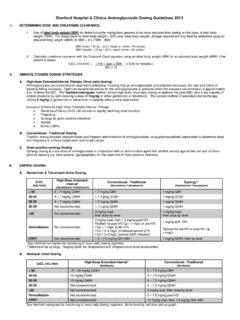Transcription of Listeriosis - NICD
1 Clinical guidelines_Listeriosis_20171205_version1 Page 1 of 19 5 DECEMBER 2017 OUTBREAK RESPONSE, DIVISION OF PUBLIC HEALTH SURVEILLANCE AND RESPONSE CENTRE FOR ENTERIC DISEASES CONTRIBUTING PHYSICIANS Listeriosis : Clinical recommendations for diagnosis and treatment Clinical guidelines_Listeriosis_20171205_version1 Page 2 of 19 Version 1 (5 December 2017): Advisory writing committee (in alphabetical order): Colleen Bamford Noma Bosman Tom Boyles Mignon Du Plessis Vindana Chibabhai Cheryl Cohen Heather Finlayson Victoria Howell Prudence Ive Karen Keddy Trudy Leong Kerrigan McCarthy Warren Lowman Marc Mendelson David Moore Jeremy Nel Arifa Parker Helena Rabie Gary Reubenson Kessendri Reddy Juanita Smit Kathy-Anne Strydom Jantjie Taljaard Juno Thomas Sithembiso Velaphi Andrew Whitelaw Guideline review: Version : To be submitted to NHLS Microbiology expert working group Summary of changes: Date reviewed Reviewed by Summary of changes Disclaimer: The information contained in this document, be it guidelines , recommendations, diagnostic algorithms or treatment regimens, are offered in this document in the public interest.
2 To the best of the knowledge of the guideline writing team, the information contained in these guidelines is correct. Implementation of any aspect of these guidelines remains the responsibility of the implementing agency in so far as public health liability resides, or the responsibility of the individual clinician in the case of diagnosis or treatment. Clinical guidelines_Listeriosis_20171205_version1 Page 3 of 19 Quick Reference Guide Listeriosis When should Listeriosis be suspected? Listeria should be considered in all cases of suspected acute bacterial meningitis. Epidemiological evidence gathered over 2017 illustrates that L. monocytogenes is now the second commonest cause of acute bacterial meningitis in South Africa. There is no data regarding the frequency of Listeriosis amongst cases of neonatal sepsis, but the number of cases identified in South Africa from January to October 2017 (n=161) suggests that L. monocytogenes should be suspected in all neonates with a diagnosis of neonatal sepsis.
3 Laboratory diagnosis of Listeria monocytogenes Neither clinical signs and symptoms, nor a negative CSF cell count or chemistry CSF cell count and chemistry are helpful in excluding the diagnosis of Listeriosis . However, L. monocytogenes is easily cultured from clinical specimens obtained from sterile sites (CSF, abscess fluid, blood). L. monocytogenes is not routinely cultured on stool specimens speak to a clinical microbiologist. Gram-positive bacilli on CSF are seen in less than 33% of culture positive cases. Therefore a negative Gram s stain does not rule out Listeria. CSF culture may be negative in cases of Listeriosis with rhombencephalitis (brainstem involvement with cranial nerve impairment), or low bacterial loads. PCR is sensitive and specific for the diagnosis of Listeria. NICD and private laboratories offer a PCR test for L. monocytogenes, and other causes of bacterial/viral meningitis. How does Listeriosis present clinically? Gastroenteritis (mean incubation <24hrs, range 6hrs-10days).
4 Flu-like symptoms in pregnant women, with premature labour and early onset neonatal sepsis (mean incubation 28 days, range 17-67 days). Neonatal sepsis, with/without respiratory distress, skin rash, granulomatosis infantiseptica. Meningitis with/without brain stem involvement, encephalitis, seizures, coma (mean incubation 10 days, range 0-21 days). Empiric treatment of acute bacterial meningitis All cases of neonatal sepsis and all cases of acute bacterial meningitis regardless of age group should be treated according to RSA EML and clinical guidelines for acute bacterial meningitis, with the addition of ampicillin at meningitis doses. See page 12 for doses. If an alternative aetiological diagnosis is made, ampicillin should be stopped. Where no pathogen is identified and no alternative diagnosis is made, empiric treatment for acute bacterial meningitis should be discontinued after 10 days. Notification of cases and additional support: Case investigation forms may be obtained from the NICD website under the Diseases A-Z tab.
5 Completed forms should be submitted by email to Laboratory support: National Institute for Communicable Diseases, Centre for Enteric Diseases: or after-hours, the NICD doctor-on-call 082 883 9920. Page 9 Page 8 Page 9 Page 9-11 Page 12 Definitive treatment of acute bacterial meningitis, bacteraemia or sepsis due to L. monocytogenes Meningitis and bacteriaemia due to Listeriosis should be treated according to the EML and South African guidelines for the treatment of acute bacterial meningitis. The addition of gentamicin in adults with meningitis may be considered but is of uncertain value in improving clinical outcomes. Page 12-15 Clinical guidelines_Listeriosis_20171205_version1 Page 4 of 19 Contents Quick Reference Guide Listeriosis .. 3 1. Introduction .. 5 2. Objectives of this clinical advisory .. 6 3. Epidemiology of Listeriosis .. 6 4. Microbiology of Listeria monocytogenes .. 8 5. Clinical presentations of Listeriosis .. 8 Asymptomatic carriage of Listeria 8 Gastroenteritis due to Listeria monocytogenes.
6 8 Listeriosis in pregnancy .. 8 Neonatal infections due to Listeria monocytogenes .. 9 Bacteraemia due to Listeria monocytogenes .. 9 Acute bacterial meningitis or invasive neurological disease due to Listeria monocytogenes .. 9 6. Diagnosis of Listeriosis .. 10 Diagnosis of Listeria bacteraemia .. 10 Diagnosis of Listeria gastroenteritis .. 10 Diagnosis of meningitis due to Listeria monocytogenes .. 10 7. Treatment of Listeriosis .. 12 Treatment of gastroenteritis due to Listeria monocytogenes .. 12 Empiric treatment of acute bacterial meningitis .. 12 Definitive treatment of invasive Listeria monocytogenes infection in neonates, children and non-pregnant adults .. 14 Treatment of Listeria monocytogenes in pregnant women .. 16 8. References .. 16 Clinical guidelines_Listeriosis_20171205_version1 Page 5 of 19 1. Introduction Listeriosis is a bacterial disease caused by the Gram-positive, rod-shaped, motile bacterium, Listeria monocytogenes.
7 The bacterium is widely distributed in nature and can be found in soil, water and contaminated food. Animals and food products such as vegetables can become contaminated from these sources. Infection with L. monocytogenes is usually asymptomatic or may result in mild to severe febrile gastroenteritis. However, in persons with weak cell-mediated immunity, Listeriosis can lead to meningitis (inflammation of the brain and spinal cord membranes) or septicaemia (blood infection). In pregnant women, Listeriosis may result in pregnancy loss (abortion) along with sepsis and meningitis of their infant. In July and August 2017, clinicians and microbiologists at a number of sites in Gauteng Province reported an increase in cases of neonatal sepsis and adult meningitis due to L. monocytogenes (Figure 1). In October 2017, 129 culture-confirmed cases of Listeriosis were reported to the NICD, and L. monocytogenes became the second most common cause of meningitis after Streptococcus pneumoniae (Figure 2).
8 In the context of an increasing number of cases of Listeriosis identified in the private and public sectors, it became apparent that clinical diagnostic and management algorithms for meningitis did not comprehensively address issues specific to infection with L. monocytogenes, and that additions were required. While the empiric management of acute bacterial meningitis is covered in the South African Essential Medicine List (EML), and comprehensively described in South African guidelines1, there are specific questions pertaining to the diagnosis and management of Listeriosis that have been made more urgent in the current epidemiological context, and that are not addressed in these guidelines . This clinical advisory seeks to address these questions by providing evidence to support responses, and also to put forward a consensus opinion of infectious disease clinicians and clinical microbiologists where evidence is conflicting or insufficient. Figure 1. Number of laboratory-confirmed cases of L.
9 Monocytogenes reported to the NICD in private (blue) and public (orange) sector patients from all provinces of South Africa, January to October 2017 Clinical guidelines_Listeriosis_20171205_version1 Page 6 of 19 Figure 2. The number of cases of culture-confirmed bacterial meningitis (public and public sector) reported to the GERMS-SA laboratory network by month of 2017. 2. Objectives of this clinical advisory The objectives of this clinical advisory are to provide clinicians with available evidence in support of responses to the following clinical, diagnostic and management questions: 1. What are the clinical presentations of Listeriosis , and when should Listeriosis be suspected? 2. When should empiric treatment for acute bacterial meningitis include cover for L. monocytogenes? 3. How sensitive and specific are diagnostic tests for L. monocytogenes, including Gram s stain, culture, latex agglutination and polymerase chain reaction (PCR)? 4. To what degree does pre-treatment with antibiotics affect diagnostic tests for L.
10 Monocytogenes? 5. Is there a place for detection of L. monocytogenes in stool? 6. When can empiric treatment for acute bacterial meningitis, which includes cover for L. monocytogenes be discontinued? 7. What specific antibiotic treatment should be given for meningitis, bacteraemia, neonatal sepsis and gastro-enteritis caused by L. monocytogenes? 8. What is the duration of treatment of bacterial meningitis, and bacteraemia due to L. monocytogenes? 3. Epidemiology of Listeriosis Amongst 440 cases of Listeriosis identified in South Africa from January to October 2017, the majority were adults (245, 56%) followed by neonates (161, 37%). The age and gender distribution is shown in Figures 3 and 4. Adults >65 years of age comprised 10% (44 cases). Amongst neonates, 114/161 (71%) and 25/161 (16%) presented on day 0 and 1 of life respectively. Amongst those adults in whom HIV status was known, 25/32 (78%) were HIV positive. Clinical guidelines_Listeriosis_20171205_version1 Page 7 of 19 Figure 3.
